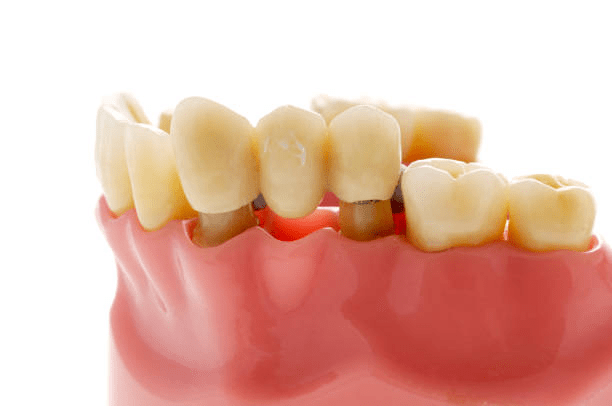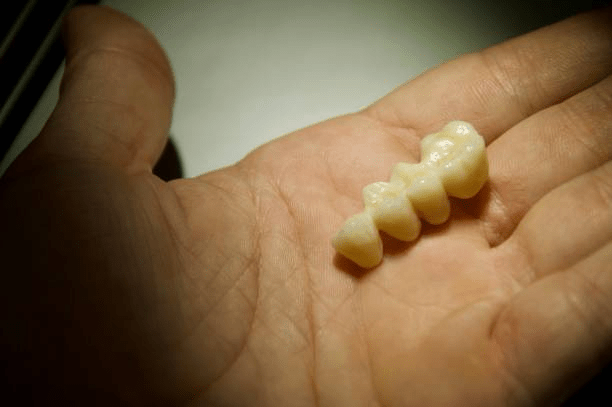
Dental bridges are a transformative dental solution for missing teeth. From improving functionality to enhancing aesthetics, dental bridges at Mountain View Dental play a pivotal role in restorative dentistry.
Curious about the process, benefits, or costs? Let’s dive in!
What is a Dental Bridge?
A dental bridge is a fixed dental restoration used to replace one or more missing teeth by "bridging" the gap between healthy teeth. This treatment not only restores your smile but also prevents potential dental issues caused by missing teeth.
Types of Dental Bridges
Traditional Dental Bridges
This is the most common type. They use crowns on adjacent teeth as anchors to hold the artificial tooth (or teeth) in place.
Cantilever Bridges
Best suited for situations where there’s only one adjacent tooth to support the bridge, cantilever bridges are less common but highly effective.
Implant-Supported Bridges
Implant-supported bridges are the most stable option, using dental implants for support instead of natural teeth. They offer durability and improved functionality.
The Dental Bridge Process
Consultation and Planning
The journey to a dental bridge begins with a comprehensive consultation. During this visit, your dentist at Mountain View Dental will evaluate your oral health, discuss your goals, and take detailed X-rays or 3D images of your teeth.
These tools help create a customized treatment plan tailored to your specific needs, ensuring the best outcome.
Preparation of Teeth
Before placing the bridge, the abutment teeth (those on either side of the gap) must be reshaped. This involves removing a small portion of enamel to make room for the crowns that will support the bridge.
While this may sound invasive, your dentist will use local anesthesia to ensure comfort throughout the procedure.
Bridge Fabrication
After preparing the abutment teeth, your dentist will take impressions or digital scans of your mouth. These serve as a blueprint for creating your custom bridge.
The fabrication process typically takes a few weeks, during which a temporary bridge may be placed to protect your teeth.
Bridge Placement
Once the permanent bridge is ready, your dentist will carefully fit and secure it in place. Adjustments are made to ensure it feels natural and aligns properly with your bite. This stage may require a few visits to perfect the fit and appearance.
Aftercare and Maintenance
Proper care is crucial to the longevity of your dental bridge. Your dentist will provide instructions on brushing, flossing, and maintaining oral hygiene.
Regular check-ups are essential to monitor the condition of the bridge and address any issues promptly.
Benefits of Dental Bridges
Improved Appearance
Dental bridges close gaps in your smile, giving you a natural and cohesive look. This boost in appearance can have a profound impact on your overall confidence and self-esteem.
Improved Speech
Missing teeth can cause difficulty pronouncing certain words or sounds. A dental bridge restores the structural integrity of your mouth, helping you speak more clearly.
Improved Chewing Function
Chewing with missing teeth can be uncomfortable or ineffective. Dental bridges restore your ability to eat a balanced diet without restrictions, ensuring you can enjoy your favorite foods.
Preserved Remaining Teeth
When a tooth is lost, adjacent teeth may shift into the empty space, leading to misalignment and potential jaw issues. A dental bridge prevents this by maintaining proper spacing.
Boosted Self-Confidence
Beyond the functional benefits, a restored smile enhances your ability to interact with others confidently, whether in social or professional settings.
Potential Drawbacks of Dental Bridges
Cost
The initial investment for a dental bridge can be substantial, particularly for high-quality materials or implant-supported options. However, many patients find the long-term benefits well worth the cost.
Potential Gum Disease
If not cleaned properly, food particles and plaque can accumulate around the bridge, increasing the risk of gum disease. Consistent oral hygiene practices are critical.
Risk of Tooth Decay
The abutment teeth supporting the bridge are more vulnerable to decay, especially if the surrounding area isn’t cleaned thoroughly.
Need for Regular Dental Check-ups
Bridges require ongoing care and monitoring to ensure they remain functional and aesthetically pleasing. Missing check-ups can lead to unnoticed issues, such as wear or damage.
Dental Bridge Materials
Porcelain-Fused-to-Metal (PFM)
PFM bridges combine the durability of metal with the natural appearance of porcelain, making them a versatile option for many patients. These are commonly used for both front and back teeth.
All-Ceramic or All-Porcelain
Perfect for front teeth, all ceramic bridges offer unparalleled aesthetics. While slightly less durable than metal-based options, they provide a seamless, lifelike appearance.
Gold
Gold bridges are known for their strength and longevity. While not as aesthetically pleasing for visible teeth, they are an excellent choice for molars due to their ability to withstand heavy chewing forces.
Dental Bridges and Pain Relief
In addition to restoring lost functionality, dental bridges can alleviate discomfort caused by misalignment or uneven bite pressure.
For instance, when gaps in the teeth lead to uneven stress on the jaw, a bridge redistributes that pressure evenly, reducing pain and discomfort.
Comparing Dental Bridges to Veneers, Implants, and Crowns
Dental Bridges vs. Veneers
Veneers focus on improving the appearance of individual teeth, particularly for cosmetic purposes. Dental bridges, on the other hand, are designed to replace missing teeth entirely, restoring both form and function.
Dental Bridges vs. Dental Implants
While implants are a permanent solution and do not rely on adjacent teeth for support, they involve a more invasive procedure and a longer recovery time. Bridges are less invasive and often more cost-effective, making them a practical choice for many patients.
Dental Bridges vs. Crowns
Crowns are used to restore the integrity of individual teeth that are damaged or decayed. In contrast, bridges span the gap created by missing teeth, relying on crowns as anchors.
Dental Bridge Cost
Factors Affecting Cost
Several factors influence the cost of a dental bridge, including the type of bridge, materials used, and the complexity of the procedure. Geographical location and the dentist’s experience also play a role.
Insurance Coverage
Most dental insurance plans cover a portion of the cost for dental bridges, but it’s essential to verify the specifics of your policy. Your dentist’s office can assist with navigating insurance claims.
Payment Plans and Financing Options
Many dental practices offer flexible payment plans or financing options to make dental bridges more accessible. Discuss these options with your dentist to find a plan that fits your budget.
Choosing a Dentist for Dental Bridge Treatment
Qualifications and Experience
Select a dentist with extensive experience in restorative dentistry. Look for credentials, continuing education, and a portfolio of successful cases to ensure you’re in capable hands.
Technology and Equipment
Modern dental practices utilize advanced technology, such as digital imaging and CAD/CAM systems, to ensure precise and efficient treatment. Opt for a dentist who stays updated with the latest innovations.
Patient Reviews and Testimonials
Read reviews and testimonials to gauge patient satisfaction. Positive feedback often reflects a dentist’s commitment to quality care and excellent results.
Mountain View Dental: Your Trusted Partner for Dental Bridge Treatment
At Mountain View Dental in Acworth, GA, we treat every patient like family. With over 30 years of experience and a stellar reputation, our dedicated team offers top-notch dental care.
Whether you need a dental bridge, Invisalign, or a smile makeover, we’ve got you covered with our comprehensive services!
Don’t let unused insurance benefits go to waste—contact us today to schedule your free consultation and achieve the smile you deserve!
Conclusion

Dental bridges are a practical, effective solution for missing teeth, restoring both functionality and aesthetics. Whether you’re considering traditional, cantilever, or implant-supported bridges, the benefits far outweigh the drawbacks.
Ready to take the next step? Let Mountain View Dental in Acworth guide you toward your perfect smile.
